Low Cost and Easy to Implement Physical and Hydrological Soil Assessment of Shade-Grown Coffee in Santa Rosa, Guatemala
Abstract
:1. Introduction
2. Materials and Methods
2.1. Study Area
2.2. Vegetation Sampling
2.3. Soil Sampling and Measurements
2.4. Visual Soil Assessment
2.5. Data Analysis
3. Results
4. Discussion
5. Conclusions
Author Contributions
Funding
Acknowledgments
Conflicts of Interest
Appendix A
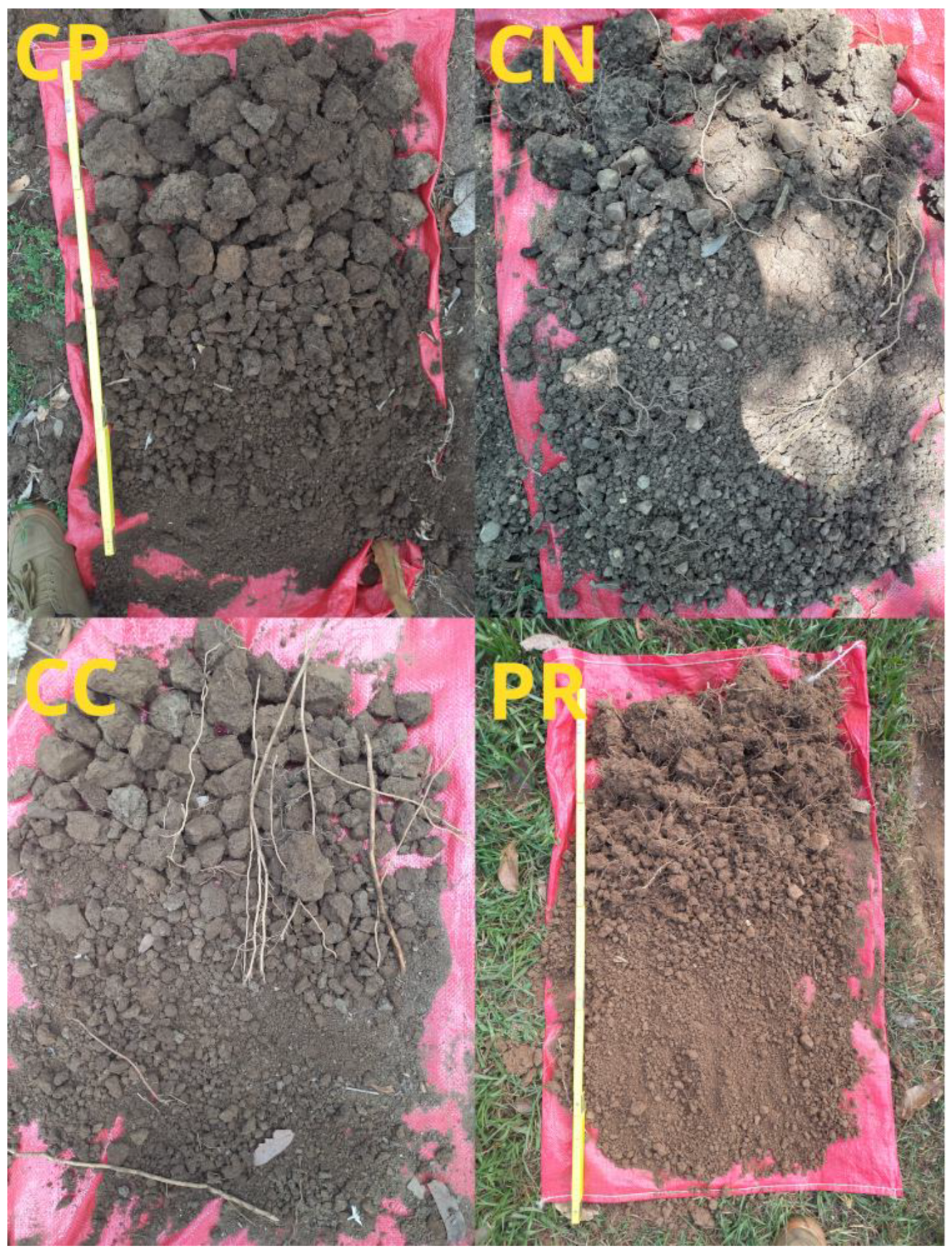
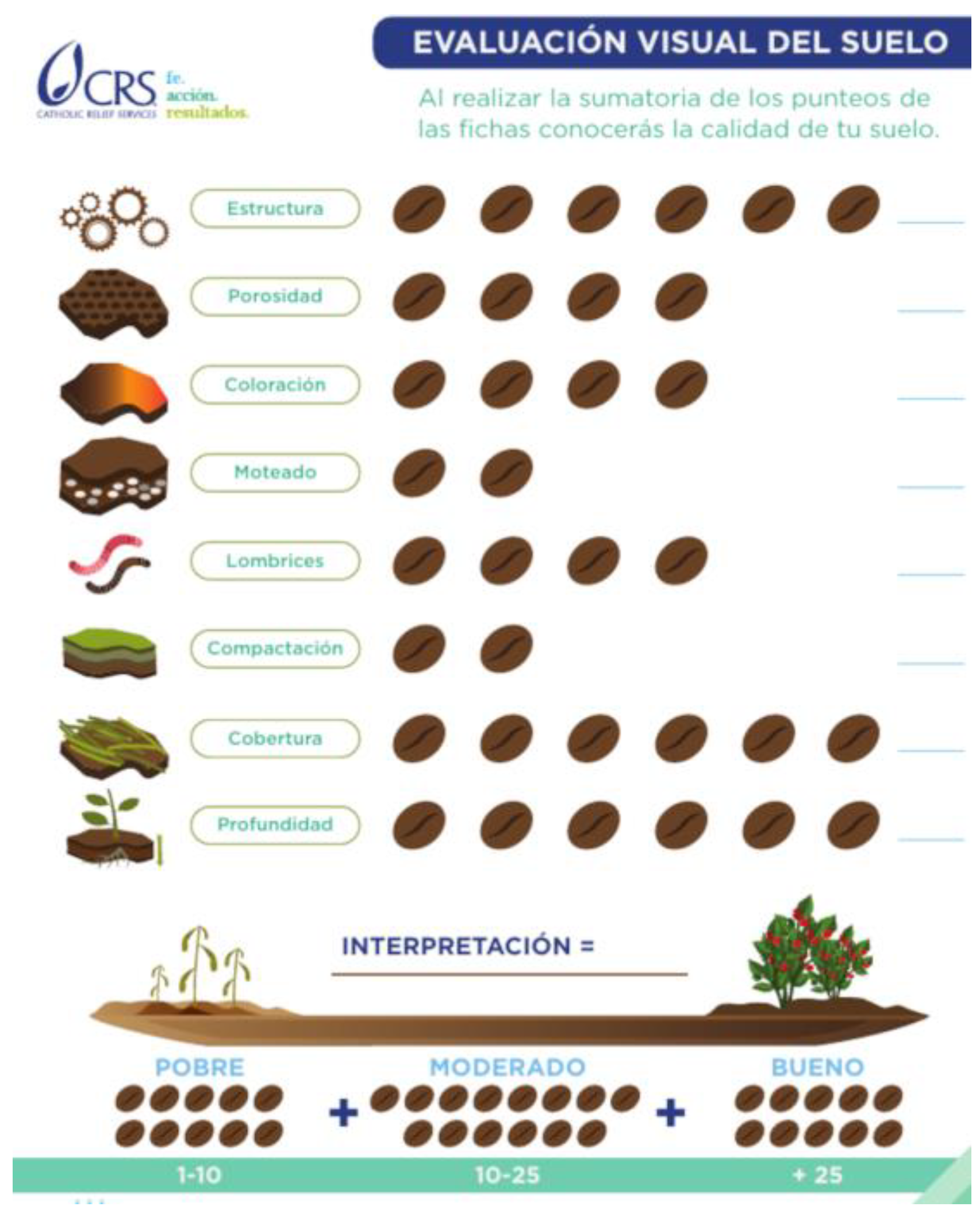
References
- Lin, B.B. The Role of Agroforestry in Reducing Water Loss through Soil Evaporation and Crop Transpiration in Coffee Agroecosystems. Agric. For. Meteorol. 2010, 150, 510–518. [Google Scholar] [CrossRef]
- Muñoz-Villers, L.E.; Geris, J.; Alvarado-Barrientos, M.S.; Holwerda, F.; Dawson, T. Coffee and Shade Trees Show Complementary Use of Soil Water in a Traditional Agroforestry Ecosystem. Hydrol. Earth Syst. Sci. 2020, 24, 1649–1668. [Google Scholar] [CrossRef] [Green Version]
- Zhu, X.; Liu, W.; Chen, J.; Bruijnzeel, L.A.; Mao, Z.; Yang, X.; Cardinael, R.; Meng, F.-R.; Sidle, R.C.; Seitz, S.; et al. Reductions in Water, Soil and Nutrient Losses and Pesticide Pollution in Agroforestry Practices: A Review of Evidence and Processes. Plant Soil 2020, 453, 45–86. [Google Scholar] [CrossRef]
- Jose, S. Agroforestry for Ecosystem Services and Environmental Benefits: An Overview. Agroforest Syst. 2009, 76, 1–10. [Google Scholar] [CrossRef]
- Lozano-Baez, S.E.; Domínguez-Haydar, Y.; Di Prima, S.; Cooper, M.; Castellini, M. Shade-Grown Coffee in Colombia Benefits Soil Hydraulic Conductivity. Sustainability 2021, 13, 7768. [Google Scholar] [CrossRef]
- Lyngbæk, A.E.; Muschler, R.G.; Sinclair, F.L. Productivity and Profitability of Multistrata Organic versus Conventional Coffee Farms in Costa Rica. Agrofor. Syst. 2001, 53, 205–213. [Google Scholar] [CrossRef]
- Grüter, R.; Trachsel, T.; Laube, P.; Jaisli, I. Expected Global Suitability of Coffee, Cashew and Avocado Due to Climate Change. PLoS ONE 2022, 17, e0261976. [Google Scholar] [CrossRef]
- Marín-Castro, B.E.; Geissert, D.; Negrete-Yankelevich, S.; Gómez-Tagle Chávez, A. Spatial Distribution of Hydraulic Conductivity in Soils of Secondary Tropical Montane Cloud Forests and Shade Coffee Agroecosystems. Geoderma 2016, 283, 57–67. [Google Scholar] [CrossRef]
- Akdemir, E.; Anderson, S.H.; Udawatta, R.P. Influence of Agroforestry Buffers on Soil Hydraulic Properties Relative to Row Crop Management. Soil Sci. 2016, 181, 368–376. [Google Scholar] [CrossRef]
- Bagarello, V.; Di Prima, S.; Iovino, M. Estimating Saturated Soil Hydraulic Conductivity by the near Steady-State Phase of a Beerkan Infiltration Test. Geoderma 2017, 303, 70–77. [Google Scholar] [CrossRef]
- Gusli, S.; Sumeni, S.; Sabodin, R.; Muqfi, I.H.; Nur, M.; Hairiah, K.; Useng, D.; van Noordwijk, M. Soil Organic Matter, Mitigation of and Adaptation to Climate Change in Cocoa–Based Agroforestry Systems. Land 2020, 9, 323. [Google Scholar] [CrossRef]
- Zimmermann, B.; Elsenbeer, H.; De Moraes, J.M. The Influence of Land-Use Changes on Soil Hydraulic Properties: Implications for Runoff Generation. For. Ecol. Manag. 2006, 222, 29–38. [Google Scholar] [CrossRef]
- Logsdon, S.D.; Jaynes, D.B. Spatial Variability of Hydraulic Conductivity in a Cultivated Field at Different Times. Soil Sci. Soc. Am. J. 1996, 60, 703–709. [Google Scholar] [CrossRef]
- Lassabatère, L.; Angulo-Jaramillo, R.; Ugalde, J.M.S.; Cuenca, R.; Braud, I.; Haverkamp, R. Beerkan Estimation of Soil Transfer Parameters through Infiltration Experiments—BEST. Soil Sci. Soc. Am. J. 2006, 70, 521. [Google Scholar] [CrossRef]
- Castellini, M.; Di Prima, S.; Moret-Fernández, D.; Lassabatere, L. Rapid and Accurate Measurement Methods for Determining Soil Hydraulic Properties: A Review. J. Hydrol. Hydromech. 2021, 69, 121–139. [Google Scholar] [CrossRef]
- Bagarello, V.; Di Prima, S.; Iovino, M. Comparing Alternative Algorithms to Analyze the Beerkan Infiltration Experiment. Soil Sci. Soc. Am. J. 2014, 78, 724. [Google Scholar] [CrossRef]
- Bagarello, V.; Di Prima, S.; Giordano, G.; Iovino, M. A Test of the Beerkan Estimation of Soil Transfer Parameters (BEST) Procedure. Geoderma 2014, 221–222, 20–27. [Google Scholar] [CrossRef]
- Di Prima, S.; Stewart, R.D.; Castellini, M.; Bagarello, V.; Najm, M.R.A.; Pirastru, M.; Giadrossich, F.; Iovino, M.; Angulo-Jaramillo, R.; Lassabatere, L. Estimating the Macroscopic Capillary Length from Beerkan Infiltration Experiments and Its Impact on Saturated Soil Hydraulic Conductivity Predictions. J. Hydrol. 2020, 589, 125159. [Google Scholar] [CrossRef]
- Lozano-Baez, S.E.; Domínguez-Haydar, Y.; Zwartendijk, B.W.; Cooper, M.; Tobón, C.; Di Prima, S. Contrasts in Top Soil Infiltration Processes for Degraded vs. Restored Lands. A Case Study at the Perijá Range in Colombia. Forests 2021, 12, 1716. [Google Scholar] [CrossRef]
- Di Prima, S.; Concialdi, P.; Lassabatere, L.; Angulo-Jaramillo, R.; Pirastru, M.; Cerdà, A.; Keesstra, S. Laboratory Testing of Beerkan Infiltration Experiments for Assessing the Role of Soil Sealing on Water Infiltration. CATENA 2018, 167, 373–384. [Google Scholar] [CrossRef]
- Lozano-Baez, S.E.; Cooper, M.; de Barros Ferraz, S.F.; Rodrigues, R.R.; Lassabatere, L.; Castellini, M.; Di Prima, S. Assessing Water Infiltration and Soil Water Repellency in Brazilian Atlantic Forest Soils. Appl. Sci. 2020, 10, 1950. [Google Scholar] [CrossRef] [Green Version]
- Lozano-Baez, S.; Cooper, M.; Ferraz, S.; Rodrigues, R.R.; Pirastru, M.; Di Prima, S. Previous Land Use Affects the Recovery of Soil Hydraulic Properties after Forest Restoration. Water 2018, 10, 453. [Google Scholar] [CrossRef] [Green Version]
- Lozano-Baez, S.E.; Cooper, M.; de Barros Ferraz, S.F.; Rodrigues, R.R.; Castellini, M.; Di Prima, S. Recovery of Soil Hydraulic Properties for Assisted Passive and Active Restoration: Assessing Historical Land Use and Forest Structure. Water 2019, 11, 86. [Google Scholar] [CrossRef] [Green Version]
- Lin, B.B. Agroforestry Management as an Adaptive Strategy against Potential Microclimate Extremes in Coffee Agriculture. Agric. For. Meteorol. 2007, 144, 85–94. [Google Scholar] [CrossRef]
- Alegre, J.C.; Cassel, D.K. Dynamics of Soil Physical Properties under Alternative Systems to Slash-and-Burn. Agric. Ecosyst. Environ. 1996, 58, 39–48. [Google Scholar] [CrossRef]
- Rigal, C.; Xu, J.; Vaast, P. Young Shade Trees Improve Soil Quality in Intensively Managed Coffee Systems Recently Converted to Agroforestry in Yunnan Province, China. Plant Soil 2020, 453, 119–137. [Google Scholar] [CrossRef]
- Leite, P.A.M.; de Souza, E.S.; dos Santos, E.S.; Gomes, R.J.; Cantalice, J.R.; Wilcox, B.P. The Influence of Forest Regrowth on Soil Hydraulic Properties and Erosion in a Semiarid Region of Brazil. Ecohydrology 2017, 11, 1–12. [Google Scholar] [CrossRef]
- De Carvalho, A.F.; Fernandes-Filho, E.I.; Daher, M.; de Gomes, L.C.; Cardoso, I.M.; Fernandes, R.B.A.; Schaefer, C.E.G.R. Microclimate and Soil and Water Loss in Shaded and Unshaded Agroforestry Coffee Systems. Agroforest Syst. 2021, 95, 119–134. [Google Scholar] [CrossRef]
- Valdivia, R.; Pilarte, F.; Espinoza, A. Evaluación Visual de Suelos, Instructivo 2; Catholic Relief Service: Baltimore, MD, USA, 2019. [Google Scholar]
- Sauvadet, M.; den Meersche, K.V.; Allinne, C.; Gay, F.; de Melo Virginio Filho, E.; Chauvat, M.; Becquer, T.; Tixier, P.; Harmand, J.-M. Shade Trees Have Higher Impact on Soil Nutrient Availability and Food Web in Organic than Conventional Coffee Agroforestry. Sci. Total Environ. 2019, 649, 1065–1074. [Google Scholar] [CrossRef]
- Gómez-Delgado, F.; Roupsard, O.; le Maire, G.; Taugourdeau, S.; Pérez, A.; van Oijen, M.; Vaast, P.; Rapidel, B.; Harmand, J.M.; Voltz, M.; et al. Modelling the Hydrological Behaviour of a Coffee Agroforestry Basin in Costa Rica. Hydrol. Earth Syst. Sci. 2011, 15, 369–392. [Google Scholar] [CrossRef] [Green Version]
- Peel, M.C.; Finlayson, B.L.; McMahon, T.A. Updated World Map of the Ko¨ppen-Geiger Climate Classification. Hydrol. Earth Syst. Sci. 2007, 12, 1633–1644. [Google Scholar] [CrossRef] [Green Version]
- The Global Historical Weather and Climate Data Santa Rosa, GT Climate Zone, Monthly Weather Averages and Historical Data. Available online: https://tcktcktck.org/guatemala/santa-rosa (accessed on 23 May 2022).
- Gil Villalba, S. Estudio Hidrológico de la Cuenca del río Los Esclavos; ICC (Instituto Privado de Investigación sobre Cambio Climático): Santa Lucía Cotzumalguapa, Guatemala, 2012; p. 67. [Google Scholar]
- Irungaray, G.E.P.; Gándara, G.A.; Monzón, J.C.R.; Ibarra, R.E.M.; Ruano, J.G. Ecosistemas de Guatemala, una aproximación basada en el sistema de clasificación de Holdridge. Revista Eutopía 2016, 44, 25–68. [Google Scholar]
- Adhikari, D.; Tiwary, R.; Singh, P.P.; Upadhaya, K.; Singh, B.; Haridasan, K.E.; Bhatt, B.B.; Chettri, A.; Barik, S.K. Ecological Niche Modeling as a Cumulative Environmental Impact Assessment Tool for Biodiversity Assessment and Conservation Planning: A Case Study of Critically Endangered Plant Lagerstroemia Minuticarpa in the Indian Eastern Himalaya. J. Environ. Manag. 2019, 243, 299–307. [Google Scholar] [CrossRef] [PubMed]
- Medina, B. Desarrollo de Guía Educativa Dirigida a Docentes para el Mejoramiento del Medio Ambiente, Clima y Sistemas Agroforestales en Plantaciones de café.; PUR Projet, FEDECOCAGUA R.L.: Santa Lucía Cotzumalguapa, Guatemala, 2020. [Google Scholar]
- Nagahage, E.A.A.D.; Nagahage, I.S.P.; Fujino, T. Calibration and Validation of a Low-Cost Capacitive Moisture Sensor to Integrate the Automated Soil Moisture Monitoring System. Agriculture 2019, 9, 141. [Google Scholar] [CrossRef] [Green Version]
- Rankoth, L.M.; Udawatta, R.P.; Anderson, S.H.; Gantzer, C.J.; Alagele, S. Cover Crop Influence on Soil Water Dynamics for a Corn–Soybean Rotation. Agrosyst. Geosci. Environ. 2021, 4, e20175. [Google Scholar] [CrossRef]
- Bermúdez- Flórez, L.N.; Cartagena-Valenzuela, J.R.; Ramírez- Builes, V.H. Soil Humidity and Evapotranspiration under Three Coffee (Coffea Arabica L.) Planting Densities at Naranjal Experimental Station (Chinchiná, Caldas, Colombia). Acta Agron. 2018, 67, 402–413. [Google Scholar] [CrossRef]
- Moroizumi, T.; Horino, H. The Effects of Tillage on Soil Temperature and Soil Water. Soil Sci. 2002, 167, 548–559. [Google Scholar] [CrossRef]
- Rstudio Team. RStudio: Integrated Development Environment for R. RStudio; RStudio, PBC: Boston, MA, USA, 2020. [Google Scholar]
- Marín-Castro, B.E.; Negrete-Yankelevich, S.; Geissert, D. Litter Thickness, but Not Root Biomass, Explains the Average and Spatial Structure of Soil Hydraulic Conductivity in Secondary Forests and Coffee Agroecosystems in Veracruz, Mexico. Sci. Total Environ. 2017, 607–608, 1357–1366. [Google Scholar] [CrossRef]
- Cannavo, P.; Sansoulet, J.; Harmand, J.-M.; Siles, P.; Dreyer, E.; Vaast, P. Agroforestry Associating Coffee and Inga Densiflora Results in Complementarity for Water Uptake and Decreases Deep Drainage in Costa Rica. Agric. Ecosyst. Environ. 2011, 140, 1–13. [Google Scholar] [CrossRef]
- Ilstedt, U.; Malmer, A.; Verbeeten, E.; Murdiyarso, D. The Effect of Afforestation on Water Infiltration in the Tropics: A Systematic Review and Meta-Analysis. For. Ecol. Manag. 2007, 251, 45–51. [Google Scholar] [CrossRef]
- Ilstedt, U.; Tobella, A.B.; Bazié, H.R.; Bayala, J.; Verbeeten, E.; Nyberg, G.; Sanou, J.; Benegas, L.; Murdiyarso, D.; Laudon, H.; et al. Intermediate Tree Cover Can Maximize Groundwater Recharge in the Seasonally Dry Tropics. Sci. Rep. 2016, 6, 1–12. [Google Scholar] [CrossRef] [PubMed] [Green Version]
- Bormann, H.; Klaassen, K. Seasonal and Land Use Dependent Variability of Soil Hydraulic and Soil Hydrological Properties of Two Northern German Soils. Geoderma 2008, 145, 295–302. [Google Scholar] [CrossRef]
- Lozano-Baez, S.E.; Cooper, M.; Meli, P.; Ferraz, S.F.B.; Rodrigues, R.R.; Sauer, T.J. Land Restoration by Tree Planting in the Tropics and Subtropics Improves Soil Infiltration, but Some Critical Gaps Still Hinder Conclusive Results. For. Ecol. Manag. 2019, 444, 89–95. [Google Scholar] [CrossRef]
- Ziegler, A.D.; Giambelluca, T.W.; Tran, L.T.; Vana, T.T.; Nullet, M.A.; Fox, J.; Vien, T.D.; Pinthong, J.; Maxwell, J.F.; Evett, S. Hydrological Consequences of Landscape Fragmentation in Mountainous Northern Vietnam: Evidence of Accelerated Overland Flow Generation. J. Hydrol. 2004, 287, 124–146. [Google Scholar] [CrossRef]
- Martínez, L.J.; Zinck, J.A. Temporal Variation of Soil Compaction and Deterioration of Soil Quality in Pasture Areas of Colombian Amazonia. Soil Tillage Res. 2004, 75, 3–18. [Google Scholar] [CrossRef]
- De Souza, G.S.; Alves, D.I.; Dan, M.L.; de Souza Lima, J.S.; da Fonseca, A.L.C.C.; Araújo, J.B.S.; de Oliveira Prata Guimarães , L.A. Soil Physico-Hydraulic Properties under Organic Conilon Coffee Intercropped with Tree and Fruit Species. Pesq. Agropec. Bras. 2017, 52, 539–547. [Google Scholar] [CrossRef] [Green Version]
- Karki, U.; Goodman, M.S. Microclimatic Differences between Young Longleaf-Pine Silvopasture and Open-Pasture. Agroforest Syst 2013, 87, 303–310. [Google Scholar] [CrossRef]
- Camargo, M.B.P. de The Impact of Climatic Variability and Climate Change on Arabic Coffee Crop in Brazil. Bragantia 2010, 69, 239–247. [Google Scholar] [CrossRef]
- Tumwebaze, S.B.; Byakagaba, P. Soil Organic Carbon Stocks under Coffee Agroforestry Systems and Coffee Monoculture in Uganda. Agric. Ecosyst. Environ. 2016, 216, 188–193. [Google Scholar] [CrossRef]
- Barradas, V.L.; Fanjul, L. Microclimatic Chacterization of Shaded and Open-Grown Coffee (Coffea Arabica L.) Plantations in Mexico. Agric. For. Meteorol. 1986, 38, 101–112. [Google Scholar] [CrossRef]
- Siles, G.; Rey, P.J.; Alcántara, J.M.; Bastida, J.M.; Herreros, J.L. Effects of Soil Enrichment, Watering and Seedling Age on Establishment of Mediterranean Woody Species. Acta Oecologica 2010, 36, 357–364. [Google Scholar] [CrossRef]
- Avelino, J.; Zelaya, H.; Merlo, A.; Pineda, A.; Ordoñez, M.; Savary, S. The Intensity of a Coffee Rust Epidemic Is Dependent on Production Situations. Ecol. Model. 2006, 197, 431–447. [Google Scholar] [CrossRef]
- Jaramillo, J.; Muchugu, E.; Vega, F.E.; Davis, A.; Borgemeister, C.; Chabi-Olaye, A. Some Like It Hot: The Influence and Implications of Climate Change on Coffee Berry Borer (Hypothenemus Hampei) and Coffee Production in East Africa. PLoS ONE 2011, 6, e24528. [Google Scholar] [CrossRef] [PubMed] [Green Version]
- do Silva, M.C.; Várzea, V.; Guerra-Guimarães, L.; Azinheira, H.G.; Fernandez, D.; Petitot, A.-S.; Bertrand, B.; Lashermes, P.; Nicole, M. Coffee Resistance to the Main Diseases: Leaf Rust and Coffee Berry Disease. Braz. J. Plant Physiol. 2006, 18, 119–147. [Google Scholar] [CrossRef] [Green Version]
- Barham, B.L.; Weber, J.G. The Economic Sustainability of Certified Coffee: Recent Evidence from Mexico and Peru. World Dev. 2012, 40, 1269–1279. [Google Scholar] [CrossRef]
- Rahn, E.; Läderach, P.; Baca, M.; Cressy, C.; Schroth, G.; Malin, D.; van Rikxoort, H.; Shriver, J. Climate Change Adaptation, Mitigation and Livelihood Benefits in Coffee Production: Where Are the Synergies? Mitig. Adapt. Strat. Glob Chang. 2014, 19, 1119–1137. [Google Scholar] [CrossRef] [Green Version]
- Meza, L.E.R. Adaptive Capacity of Small-Scale Coffee Farmers to Climate Change Impacts in the Soconusco Region of Chiapas, Mexico. Clim. Dev. 2015, 7, 100–109. [Google Scholar] [CrossRef]
- Philpott, S.M.; Lin, B.B.; Jha, S.; Brines, S.J. A Multi-Scale Assessment of Hurricane Impacts on Agricultural Landscapes Based on Land Use and Topographic Features. Agric. Ecosyst. Environ. 2008, 128, 12–20. [Google Scholar] [CrossRef]
- Sepúlveda, R.B.; Carrillo, A.A. Soil Erosion and Erosion Thresholds in an Agroforestry System of Coffee (Coffea Arabica) and Mixed Shade Trees (Inga Spp and Musa Spp) in Northern Nicaragua. Agric. Ecosyst. Environ. 2015, 210, 25–35. [Google Scholar] [CrossRef]
- Zwartendijk, B.W.; van Meerveld, H.J.; Ghimire, C.P.; Bruijnzeel, L.A.; Ravelona, M.; Jones, J.P.G. Rebuilding Soil Hydrological Functioning after Swidden Agriculture in Eastern Madagascar. Agric. Ecosyst. Environ. 2017, 239, 101–111. [Google Scholar] [CrossRef] [Green Version]
- Ghimire, C.P.; Bruijnzeel, L.A.; Bonell, M.; Coles, N.; Lubczynski, M.W.; Gilmour, D.A. The Effects of Sustained Forest Use on Hillslope Soil Hydraulic Conductivity in the Middle Mountains of Central Nepal: Sustained Forest Use And Soil Hydraulic Conductivity. Ecohydrology 2014, 7, 478–495. [Google Scholar] [CrossRef]
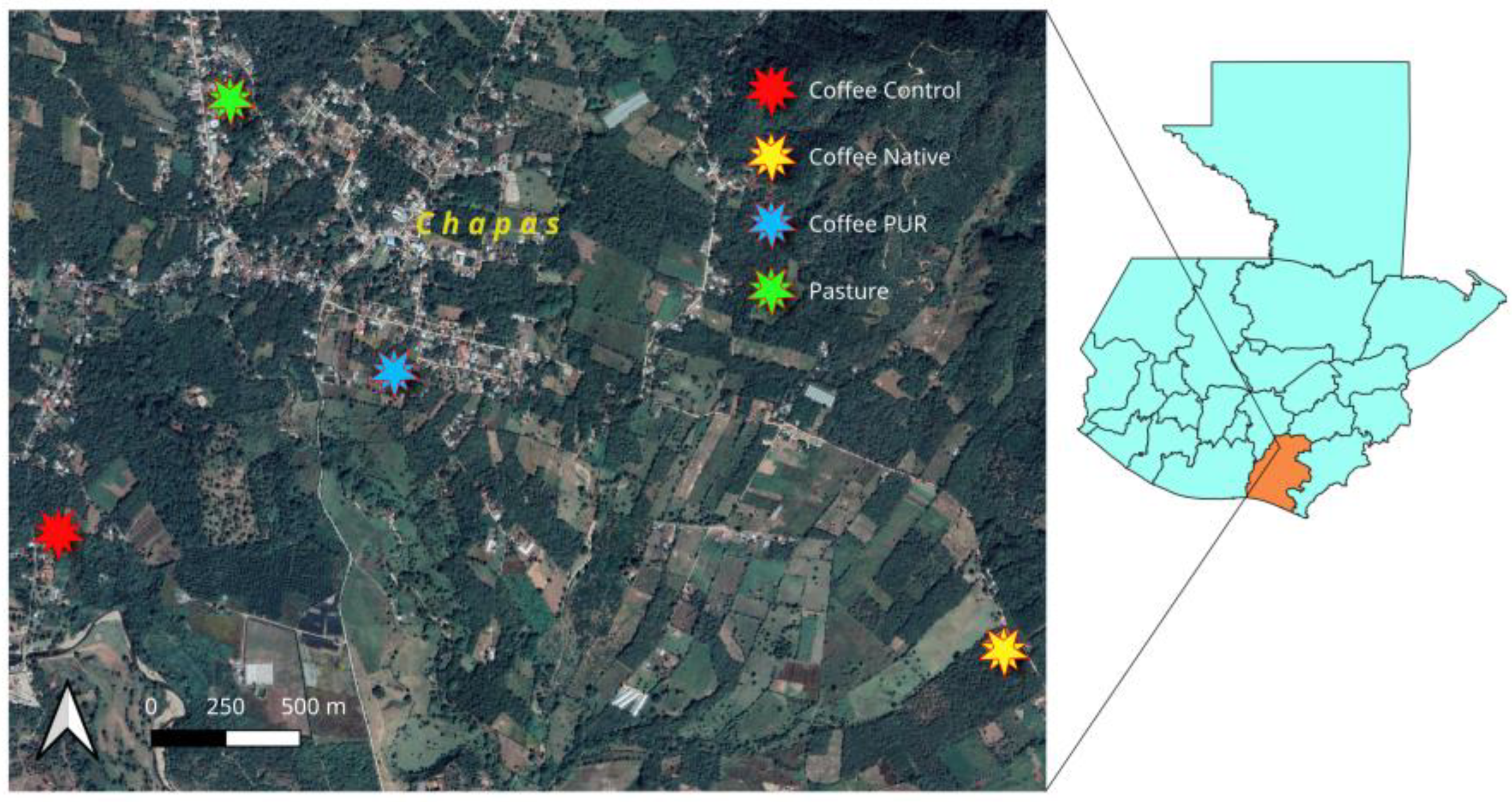
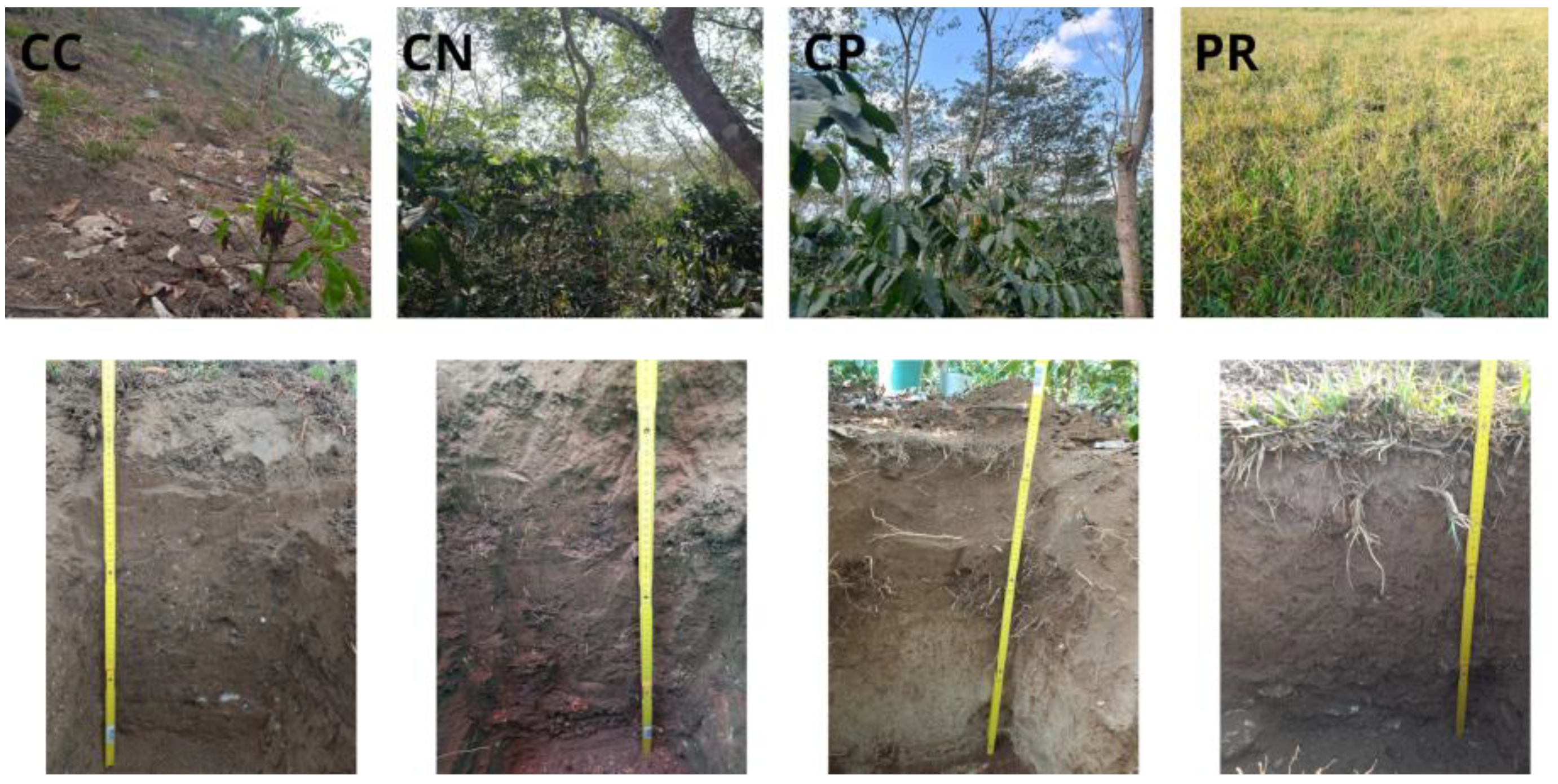
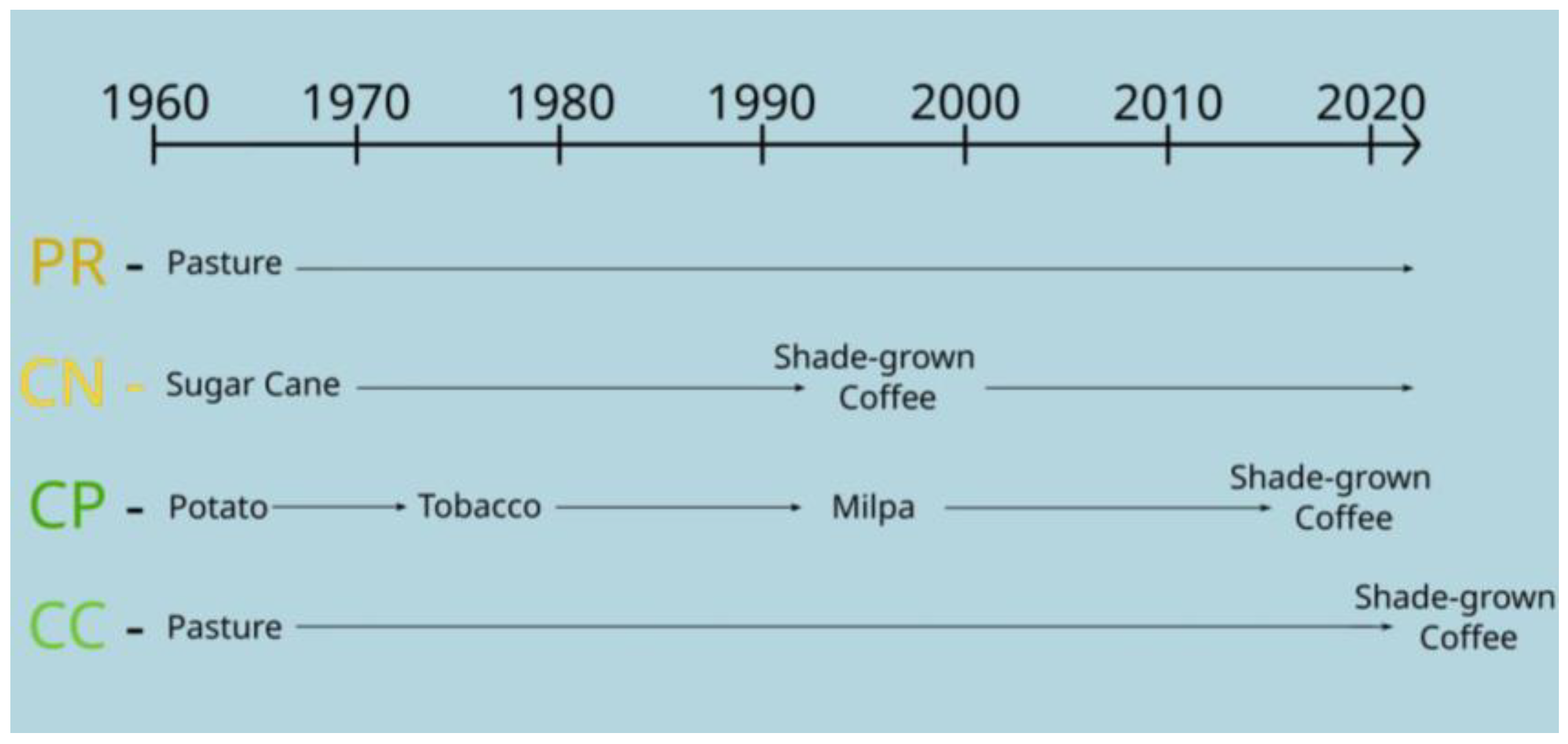
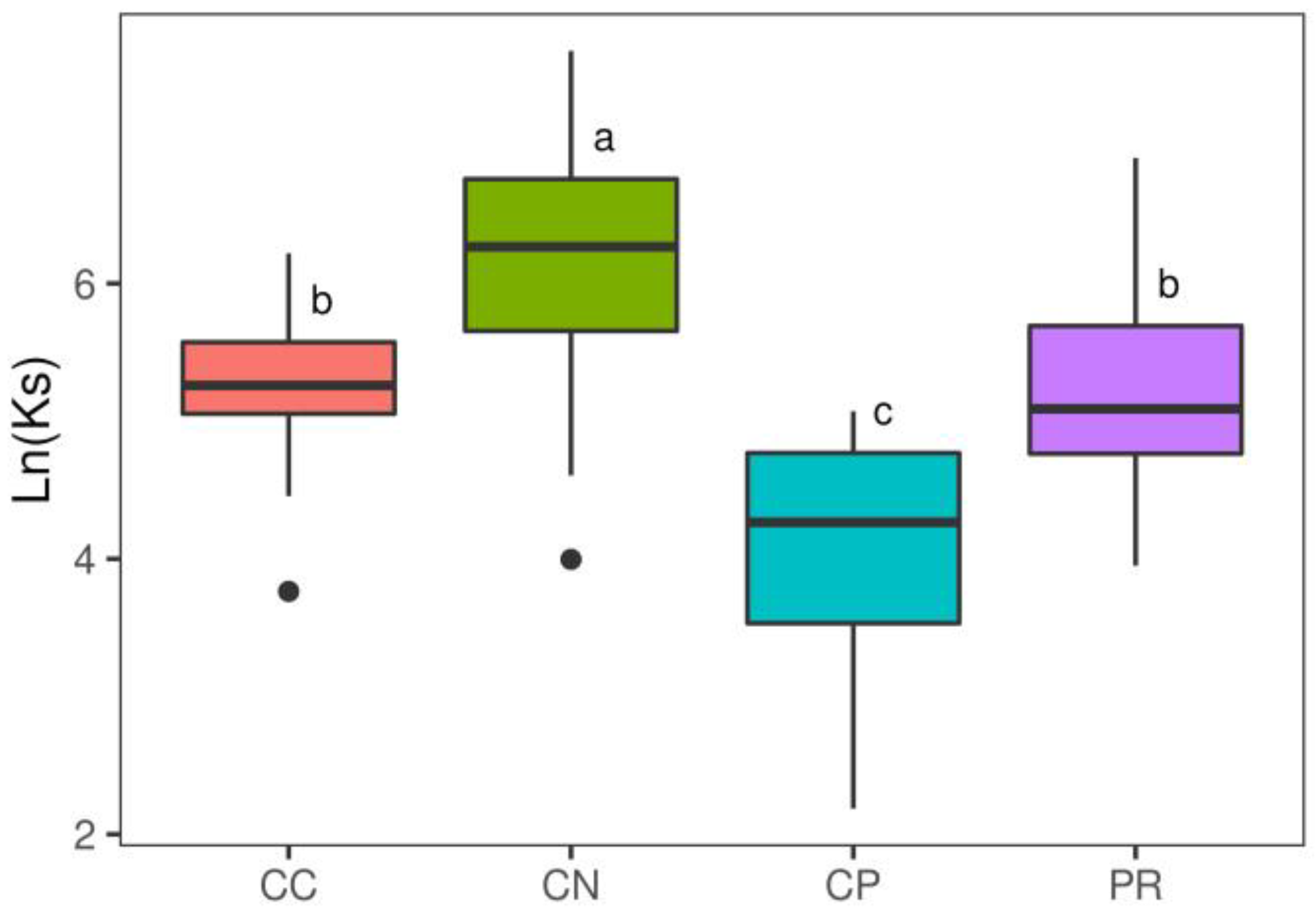
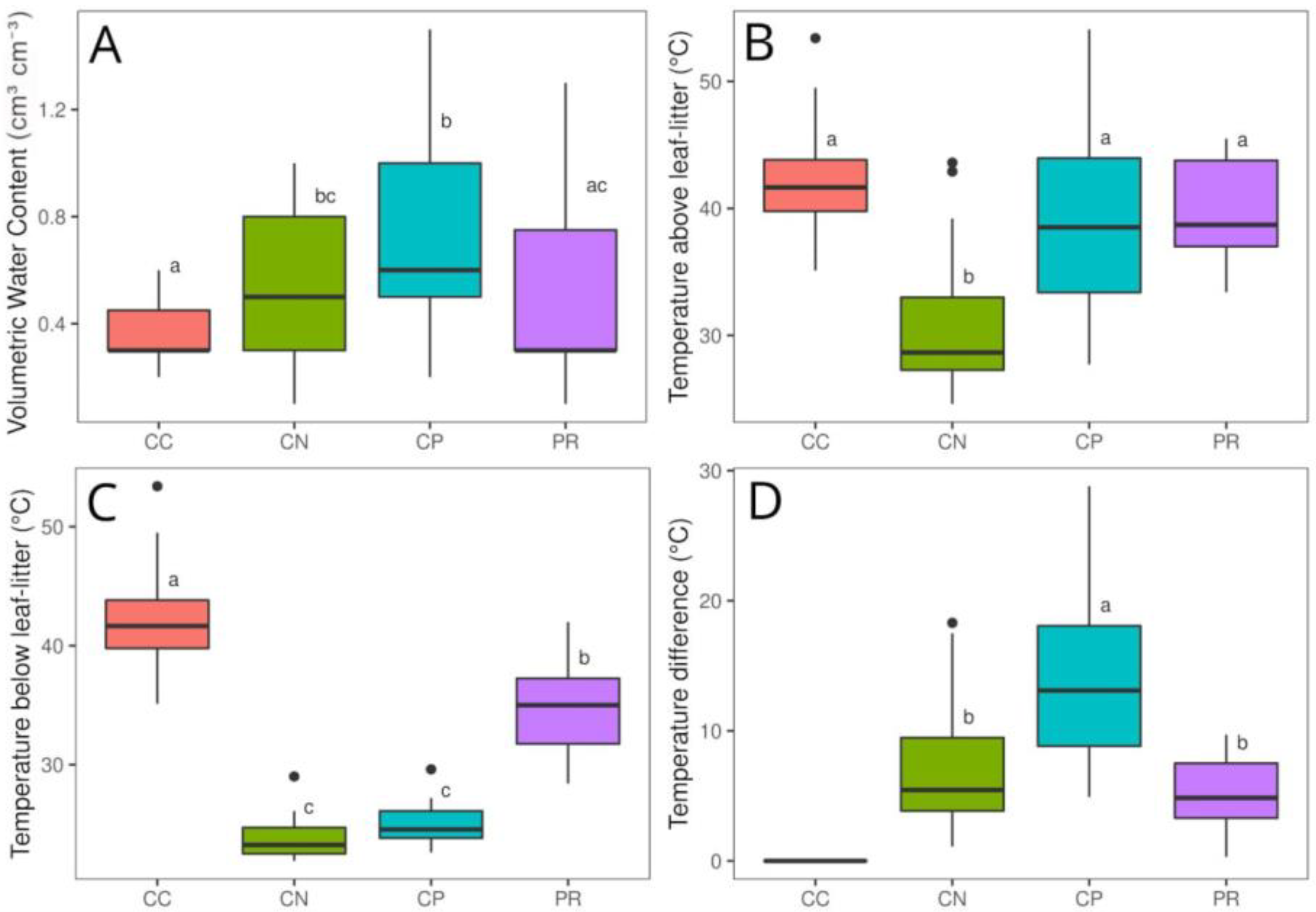
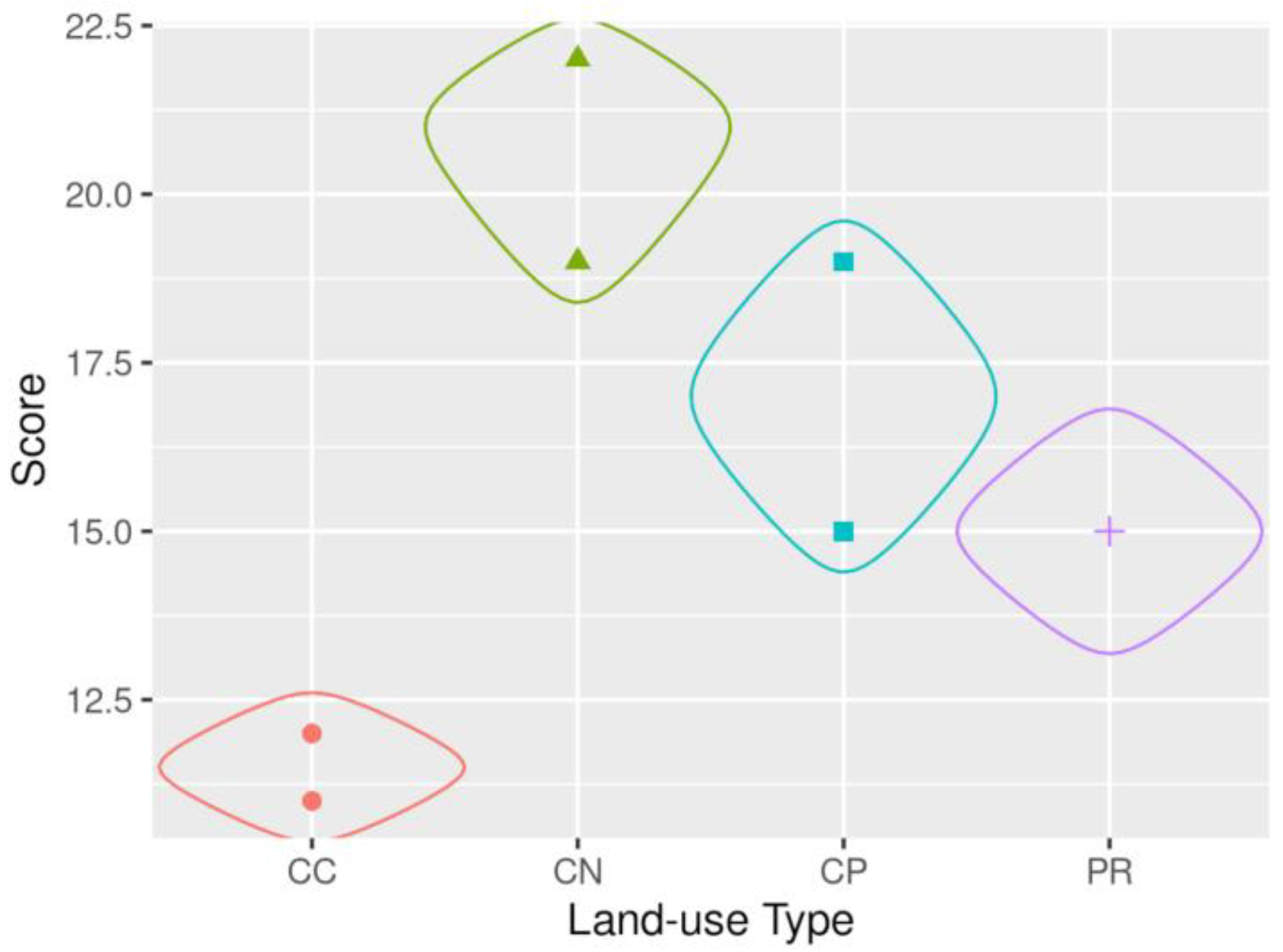
| Month | T° Max | T° Min | Rainfall (mm) | Solar Radiation Max |
|---|---|---|---|---|
| January | 33.1 | 9.3 | 8.5 | 226.3 |
| February | 33.12 | 10.8 | 20.5 | 323.5 |
| March | 34.0 | 11.8 | 23.1 | 278.3 |
| April | 35.1 | 12.0 | 28.4 | 292.2 |
| Variable | CN | CP |
|---|---|---|
| Canopy cover (%) | 63.8 ± 1.10 a (6.97) | 25.5 ± 0.87 b (5.50) |
| Vegetation height of tree (m) | 11.38 ± 1.69 a (4.78) | 9.93 ± 0.72 a (1.75) |
| DBH (m) | 0.53 ± 0.10 a (0.29) | 0.50 ± 0.45 a (0.11) |
| Total number of trees | 8 | 6 |
| Soil Cover | Live Biomass (%) | Dead Biomass (%) | Bare Soil (%) |
|---|---|---|---|
| CC | 30 | 20 | 50 |
| CN | 28 | 70 | 2 |
| CP | 21 | 70 | 9 |
| PR | 100 | 0 | 0 |
| LUS | ρb | θfc | θpm | Clay (%) | Silt (%) | Sand (%) | pH | Textural Class |
|---|---|---|---|---|---|---|---|---|
| CC | 1.11 | 0.2227 | 0.1359 | 6.6 | 18.1 | 75.2 | 4.8 | Sandy loam |
| CN | 1.18 | 0.2541 | 0.1389 | 28.7 | 24.4 | 45.8 | 4.7 | Sandy clay loam |
| CP | 1.11 | 0.2196 | 0.1203 | 21.3 | 22.7 | 55.9 | 4.4 | Sandy clay loam |
| PR | 1.05 | 0.3207 | 0.2008 | 33.9 | 30.7 | 35.3 | 5.0 | Sandy clay loam |
| Variable | Land-Use Type | Min | Max | Mean | CV |
|---|---|---|---|---|---|
| Ks (mm h−1) | CC | 43.1 | 502 | 224 b | 54 |
| CN | 54.4 | 2185 | 688 a | 87 | |
| CP | 8.9 | 160 | 75.5 cd | 61 | |
| CP1 | 8.9 | 160 | 47.3 d | 92 | |
| CP2 | 66.2 | 146 | 103.8 bc | 27 | |
| PR | 51.9 | 1004 | 302 b | 100 | |
| VWC (cm3 cm−3) | CC | 0.2 | 0.6 | 0.36 b | 38 |
| CN | 0.1 | 1.0 | 0.56 ab | 52 | |
| CP | 0.2 | 1.5 | 0.62 a | 55 | |
| PR | 0.1 | 1.3 | 0.50 ab | 63 | |
| TAL (°C) | CC | 35.1 | 53.4 | 41.8 a | 11 |
| CN | 24.6 | 43.6 | 31.0 b | 19 | |
| CP | 27.7 | 54.1 | 38.8 a | 18 | |
| PR | 33.4 | 45.5 | 39.7 a | 10 | |
| TBL (°C) | CC | 35.1 | 53.4 | 41.8 a | 11 |
| CN | 21.9 | 29 | 23.8 c | 7 | |
| CP | 22.6 | 29.6 | 25.0 c | 7 | |
| PR | 28.4 | 42 | 34.8 b | 12 | |
| TD (°C) | CC | - | - | - | - |
| CN | 1.1 | 18.3 | 7.3 b | 70 | |
| CP | 4.9 | 28.8 | 13.8 a | 44 | |
| PR | 0.3 | 9.7 | 4.9 b | 55 |
| Land-Use Type | Plot | Structure | Porosity | Color | Mottled | Earthworms | Compaction | Soil Cover | Depth | Total Score |
|---|---|---|---|---|---|---|---|---|---|---|
| CC | i | 2 | 2 | 2 | 1 | 0 | 1 | 3 | 0 | 11 |
| ii | 2 | 3 | 2 | 1 | 0 | 1 | 2 | 0 | 12 | |
| CN | i | 3 | 4 | 4 | 2 | 0 | 1 | 6 | 2 | 22 |
| i | 4 | 4 | 2 | 2 | 2 | 2 | 3 | 0 | 19 | |
| ii | 3 | 4 | 3 | 2 | 0 | 1 | 6 | 3 | 22 | |
| CP | i | 3 | 2 | 2 | 2 | 0 | 1 | 5 | 0 | 15 |
| ii | 3 | 2 | 2 | 3 | 0 | 1 | 5 | 3 | 19 | |
| PR | i | 3 | 4 | 2 | 2 | 0 | 1 | 3 | 0 | 15 |
| ii | 3 | 4 | 2 | 2 | 0 | 1 | 3 | 0 | 15 | |
| Highest score possible | 6 | 4 | 4 | 2 | 4 | 2 | 6 | 6 | 34 | |
Disclaimer/Publisher’s Note: The statements, opinions and data contained in all publications are solely those of the individual author(s) and contributor(s) and not of MDPI and/or the editor(s). MDPI and/or the editor(s) disclaim responsibility for any injury to people or property resulting from any ideas, methods, instructions or products referred to in the content. |
© 2023 by the authors. Licensee MDPI, Basel, Switzerland. This article is an open access article distributed under the terms and conditions of the Creative Commons Attribution (CC BY) license (https://creativecommons.org/licenses/by/4.0/).
Share and Cite
Gerlach, M.D.; Lozano-Baez, S.E.; Castellini, M.; Guzman, N.; Gomez, W.A.; Medina, B. Low Cost and Easy to Implement Physical and Hydrological Soil Assessment of Shade-Grown Coffee in Santa Rosa, Guatemala. Land 2023, 12, 390. https://doi.org/10.3390/land12020390
Gerlach MD, Lozano-Baez SE, Castellini M, Guzman N, Gomez WA, Medina B. Low Cost and Easy to Implement Physical and Hydrological Soil Assessment of Shade-Grown Coffee in Santa Rosa, Guatemala. Land. 2023; 12(2):390. https://doi.org/10.3390/land12020390
Chicago/Turabian StyleGerlach, Marcelo Daniel, Sergio Esteban Lozano-Baez, Mirko Castellini, Nery Guzman, Wilmer Andrés Gomez, and Bayron Medina. 2023. "Low Cost and Easy to Implement Physical and Hydrological Soil Assessment of Shade-Grown Coffee in Santa Rosa, Guatemala" Land 12, no. 2: 390. https://doi.org/10.3390/land12020390
APA StyleGerlach, M. D., Lozano-Baez, S. E., Castellini, M., Guzman, N., Gomez, W. A., & Medina, B. (2023). Low Cost and Easy to Implement Physical and Hydrological Soil Assessment of Shade-Grown Coffee in Santa Rosa, Guatemala. Land, 12(2), 390. https://doi.org/10.3390/land12020390








